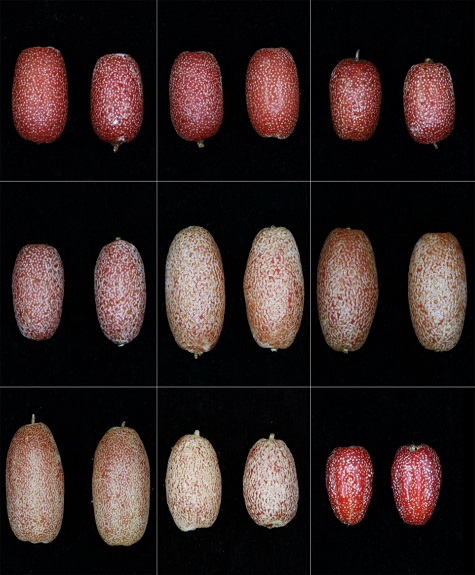

胡颓子属5种植物果实主要类胡萝卜素成分及含量
? 共同第一作者
收稿日期: 2015-06-15
录用日期: 2015-07-24
网络出版日期: 2016-05-24
基金资助
国家自然科学基金(No.31071775)、浙江科技计划(No.2008C24006)和浙江省重中之重学科开放基金(No.2011KFJJ001)
Determination of Carotenoids in Fruit of Five Elaeagnus spp. Genotypes by High Performance Liquid Chromatography
? These authors contributed equally to this paper
Received date: 2015-06-15
Accepted date: 2015-07-24
Online published: 2016-05-24
利用高效液相色谱法对华东地区常见的胡颓子属(Elaeagnus) 4种生态型的胡颓子(E. pungens)、2个变种的大叶胡颓子(E. macrophylla)、蔓胡颓子(E. glabra)、银果胡颓子(E. magna)和佘山胡颓子(E. argyi) 9个样品成熟果实所含主要类胡萝卜素成分及含量进行了检测。结果表明, 5种胡颓子属植物成熟果实中的主要类胡萝卜素成分为番茄红素, 且在不同种间含量差异显著, 含量最高的是浙江嵊州的胡颓子, 其值为(259.89±26.22) µg·g-1FW, 最低的是佘山胡颓子, 其含量为(91.19±7.74) µg·g-1FW; 其中4种生态型的胡颓子的番茄红素含量都较高。研究表明这5种胡颓子属植物果实富含番茄红素, 是一类珍贵的天然番茄红素资源, 具有较大的市场开发应用价值。研究结果为揭示果实高积累番茄红素的机理提供了理想的研究材料。

杨玲 , 程珍霞 , 李玲艳 , 陈建华 , 胡海涛 . 胡颓子属5种植物果实主要类胡萝卜素成分及含量[J]. 植物学报, 2016 , 51(3) : 306 -310 . DOI: 10.11983/CBB15106
This study analyzed carotenoid types and content in the fruit of several Elaeagnus spp. including 4 ecotypes of E. pungens, 2 varieties of E. macrophylla, E. glabra, E. magna and E. argyi, by high performance liquid chromatography (HPLC). Lycopene is the major carotenoid in the fleshy pulp, and their content differed between the 5 genotypes. The greatest mean lycopene content was up to (259.89±26.22) µg·g-1 fresh weight (FW) in E. pungens from Shengzhou of Zhejiang and the lowest was (91.19±7.74) µg·g-1 FW in E. argyi. The lycopene content was high in all 4 ecotypes of E. pungens. The flesh of the 5 Elaeagnus spp. showed abundant lycopene, for beneficial fruit resources with important development and application value. These genotypes are also ideal research material for studying the mechanism of high accumulation of lycopene in fruit.

| [1] | 崔大方, 付勉兴, 陈考科, 刘柯 (2008). 广东省胡颓子属植物种质资源及果实利用评价. 植物资源与环境学报 17, 57-61. |
| [2] | 胡海涛, 金晓琴, 成龙平, 杨莉, 陈建华, 番汝昌, 杨玲 (2014). 密花胡颓子果实主要类胡萝卜素组分及含量分析. 中国农业科学 47, 1652-1656. |
| [3] | 毛学文 (1997). 披针叶胡颓子果实营养成分的测定. 植物学通报 14(3), 59-60. |
| [4] | 陶俊, 张上隆, 徐建国, 刘春荣 (2003). 柑橘果实主要类胡萝卜素组分及含量分析. 中国农业科学 36, 1202-1208. |
| [5] | 徐晓丹, 郑伟, 钟晓红 (2007). 胡颓子属种质资源开发利用研究进展. 湖南农业科学 5, 44-46. |
| [6] | 杨燕红 (2011). 胡颓子属植物研究进展. 北方园艺 13, 197-201. |
| [7] | Cazzonelli CI (2011). Carotenoids in nature: insights from plants and beyond. Funct Plant Biol 38, 833-847. |
| [8] | Farré G, Sanahuja G, Naqvi S, Bai C, Capell T, Zhu C, Christou P (2010). Travel advice on the road to carotenoids in plants.Plant Sci 179, 28-48. |
| [9] | Fordham IM (2001). Fruit of autumn olive: a rich source of lycopene.Hortscience 36, 1136-1137. |
| [10] | Fordham IM, Zimmerman RH, Black BL, Clevidence BM, Wiley ER (2003). Autumn olive: a potential alternative crop.Acta Horticulturae 626, 437-439. |
| [11] | Guo XL, Yang L, Hu HT, Yang L (2009). Cloning and expression analysis of carotenogenic genes during ripening of autumn olive fruit.J Agric Food Chem 57, 5334-5339. |
| [12] | Xu CJ, Fraser PD, Wang WJ, Bramley PM (2006). Differences in the carotenoid content of ordinary Citrus and lycopene-accumulating mutants.J Agric Food Chem 54, 5474-5481. |
/
| 〈 |
|
〉 |